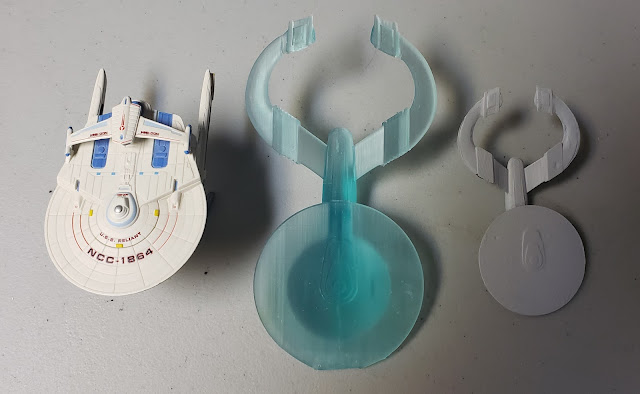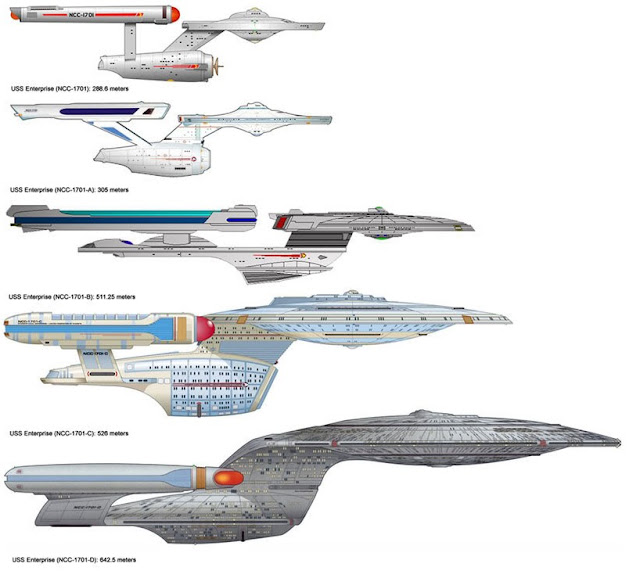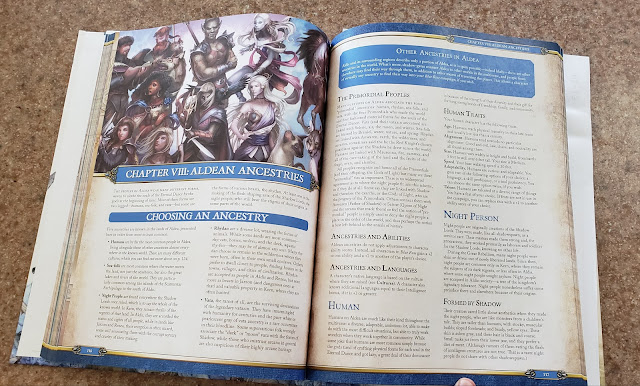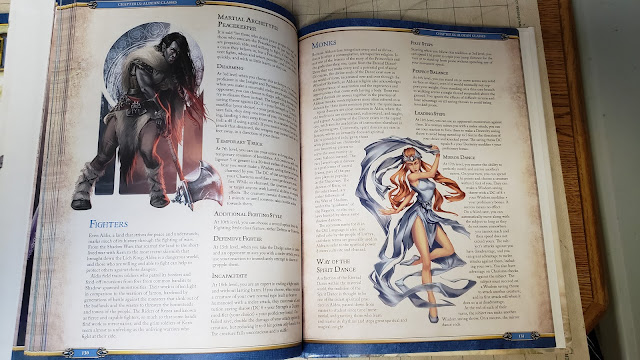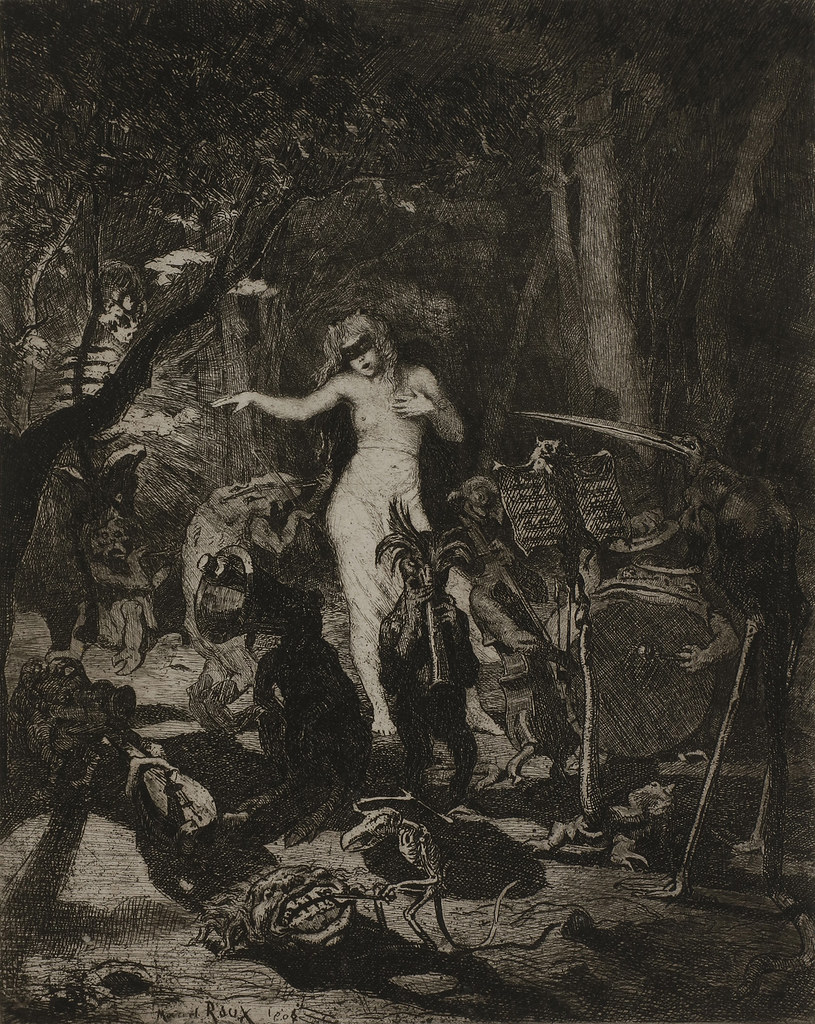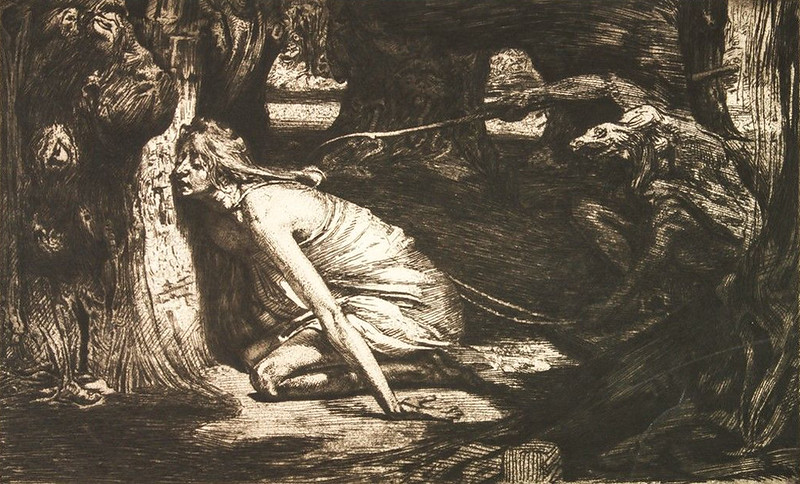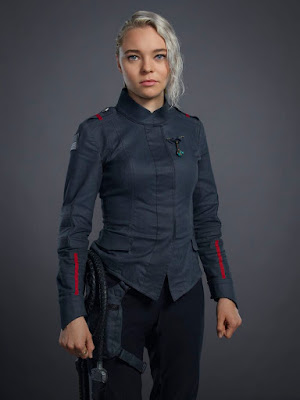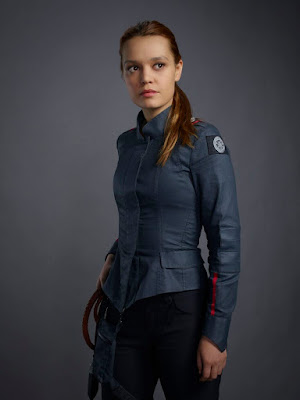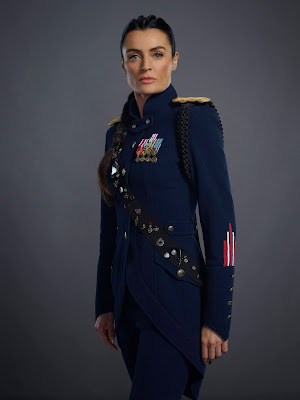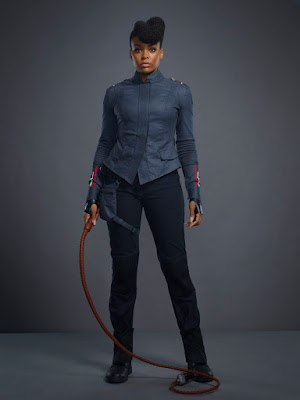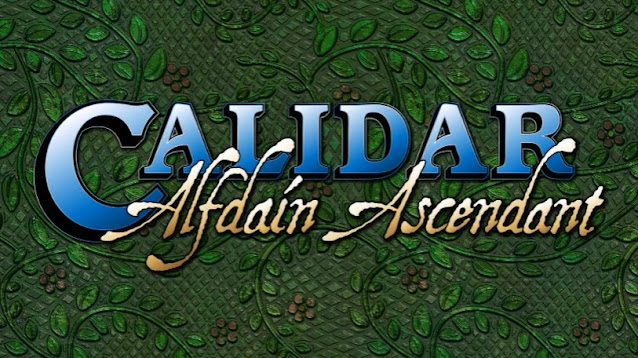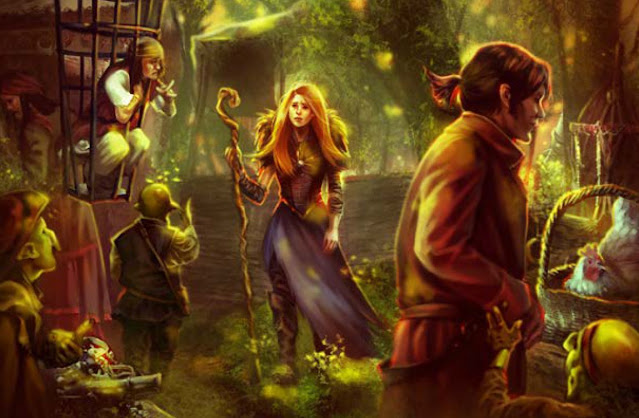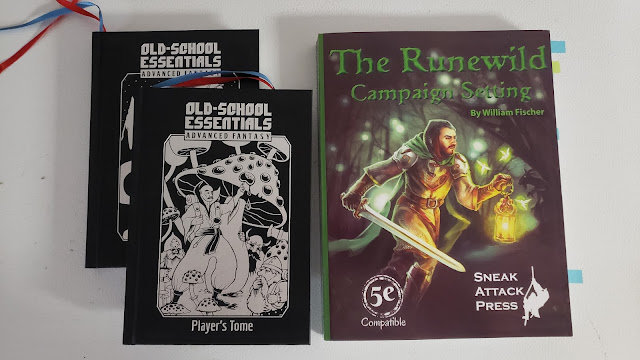1974 is an important year for the gaming hobby. It is the year that Dungeons & Dragons was introduced, the original RPG from which all other RPGs would ultimately be derived and the original RPG from which so many computer games would draw for their inspiration. It is fitting that the current owner of the game, Wizards of the Coast, released the new version, Dungeons & Dragons, Fifth Edition, in the year of the game’s fortieth anniversary. To celebrate this, Reviews from R’lyeh will be running a series of reviews from the hobby’s anniversary years, thus there will be reviews from 1974, from 1984, from 1994, and from 2004—the thirtieth, twentieth, and tenth anniversaries of the titles. These will be retrospectives, in each case an opportunity to re-appraise interesting titles and true classics decades on from the year of their original release.
—oOo—
Sometimes the choice of game to review is not yours to make. So, it is, once again, with this review. This review came as a surprise and was completely unplanned. But with the sad news of the death of
Andrew Hackard at Steve Jackson Games, it seemed timely to review the card game which he was in charge of and would take out into the gaming hobby with versions like
Munchkin Warhammer Age of Sigmar,
Munchkin Pathfinder, and
Munchkin Gloom. Then into the mainstream with editions which date have included
Munchkin SpongeBob SquarePants,
Munchkin: Disney,
Munchkin: Disney Duck Tales,
Munchkin Harry Potter,
Munchkin Teenage Mutant Ninja Turtles, and
Munchkin Shakespeare. Then when Reviews from R’lyeh checked when
Munchkin was first published, the year 2001, it was obvious that a twentieth anniversary review was warranted, and when upon finding that the nearest copy to hand had never been opened, an
Unboxing in the Nook, was also required. So this review is both a retrospective and an acknowledgement that the hobby has lost another who by all accounts was a good friend and will be much missed.
—oOo—
 Munchkin
Munchkin is many things. It is a fantasy roleplaying game without any roleplaying. It is a fantasy card game which parodies fantasy roleplaying. It is a silly fantasy card game with a clever design. It is a fantasy card game which parodies
Dungeons & Dragons. It is a dungeon exploration game without a dungeon. It is a fantasy card game which parodies a particular play style of fantasy roleplaying. It is a fantasy card game which understands its genre. It is a fantasy card game with simple rules, but sophisticated interaction of its cards. It is a fantasy card game whose format has become a template for numerous variations, iterations, licences, and accessories. It is a fantasy card game which won the
2001 Origins Awards for Best Traditional Card Game. Above all, it is a fantasy card game which is not just fun to play, it can be laugh out loud fun to play.
So the first question is, what is a ‘Munchkin’? The most obvious answer is the race of little people from Frank L. Baum’s The Wonderful Wizard of Oz, enslaved by the Wicked Witch of the East. In roleplaying parlance, a ‘Munchkin’ is the type of roleplayer—typically a roleplayer of Dungeons & Dragons (but it applies to any roleplaying game)—who will always try and maximise his character’s stats, kill anything in his path for the maximum Experience Points possible, find and optimise the best gear and/or magical items possible, and acquire as many Levels as he can, all the while ignoring the roleplaying aspects of the game, his character’s personality, and that of any other Player Character around the table to the detriment of everyone else’s fun. Unless of course, everyone else is also a Munchkin, in which case, all bets are off! Munchkins are not always fun to game with and to an extent this can be true of the Munchkin card game. It can outstay its welcome. However, Munchkin is both fun to play and funny.
So in Munchkin the card game you are attempting to be the most munch-kiny. To out-munchkin your fellow munchkins. To be the munchkin’s munchkin. To win, to be top Munchkin, you need to be the first to acquire Level Ten—and you start at Level One. To go up a Level, you need to kill monsters. Kill a monster, gain a Level. Monsters can be hard though, and you need better treasure and better gear which will improve your ability to kill Monsters. Better treasure and better gear comes from killing monsters. Sometimes you are never going to kill a monster on your own—you are just not enough of a munchkin. So you negotiate with your fellow munchkins for a share of the treasure, and together you might defeat that tough monster—but you gain the Level. Ultimately, when Level Ten is in sight and you have chance of being the uber-munchkin, negotiating and working together is not going to work. It is just you and the monster (and whatever monsters and perils your rival munchkins can throw into your path) and your bestest gear. Never fear though, YOU will get to Level Ten!
First published in 2001, Munchkin from Steve Jackson Games is designed for three to six players, aged twelve and up. It has a playing time of an hour, but games typically last half that time. It consists of two decks of cards—Dungeon cards and Treasure cards. Dungeon cards have a dungeon door on the back whilst Treasure cards have a pile of loot. Chief amongst the Dungeon cards are the monster cards, from the lowly Level 1 Potted Plant and Drooling Slime to the dread Level 20 Squidzilla and the Level 20 Plutonium Dragon. Defeat them and not only are your rewarded with Treasure cards, but also a Level or two, depending on the toughness of the monster. Fail to defeat them and a monster might kill you (it’s okay, you can start again back at Level One), make you lose a Level, or lose an item. Others includes Curses like ‘Curse! Income Tax’ or ‘Curse! Duck of Doom’ which force you to discard items; and Classes, Races, and Genders—Cleric, Thief, Warrior, and Wizard, Dwarf, Elf, and Halfling (Human is the default), and Male and Female. The Classes, Races, and Genders will often determine what gear you can and what magical items and weapons you can wield, and lose the wrong one or have it changed to another, perhaps because of a Curse! and you lose the associated items.
The Treasure cards include single use items like potions, like the ‘Polymorph Potion’, which turns a monster into a parrot which flies away, leaving behind its treasure, and spells, like ‘Magic Missile’ which adds a one-use bonus in combat. Then there are magic items—lots and lots of magic items. These include the ‘Kneepads of Allure’ which force another player to help you, and ‘Boots of Butt-Kicking’ and ‘Chainsaw of Bloody Dismemberment’, both of which add bonuses when you fight monsters. There is a limit to how many items you can carry—one item of footwear, one item of head gear, suit of armour, an item in each hand, or an item in both hands, just as you would in a fantasy roleplaying game.
Munchkin is quite simple to play. At the start of the game, you and the other players receive four cards, receive two Dungeon cards and two Treasure cards, and equip yourself from them as best you can. On your turn, you ‘Open a Door’ and draw a card from the Dungeon deck. If a monster, you fight it or you run away. If not, the card goes into your hand or is equipped immediately, or if a Curse!, played immediately. If you did not encounter a monster, you can ‘Look for Trouble’ and play one from your hand. Either way, if you defeat the monster, go up a Level, and you can ‘Loot the Room’ and draw cards from the Treasure deck.
To defeat a monster, the total of your Level, plus bonuses from any items equipped and any one-shot items must be greater than that of the monster’s Level. However a rival can play cards which will hinder you and so prevent you from defeating the monster. Then you have two options. One is to run away, but doing so may have consequences depending on the monster faced, as well as losing any opportunity of gaining any treasure. Alternatively, you can ‘Ask for Help’. Essentially, bribe another player into helping you defeat a monster that you cannot defeat on your own, typically with the treasure, or the best of the treasure that you will find when you ‘Loot the Room’. This can become a negotiation and even if another player agrees to help you, it does not stop a rival from throwing in cards to further hinder you.
Play continues like this until a player reaches Level Nine and looks ready to get to Level Ten and win the game. Then all bets are off. Up until this point, players have been hindering each other because they can, because it is funny, because they do not want to see another player gain a hoard of treasure cards, but now… But now, they have to stop the player in the lead from winning. If there is another player in the lead, then give his opponent a potion which will increase its Level, send a Wandering Monster in his way and increase the number he has to fight, Backstab him (if you are a lowdown, sneaky Thief), or curse them with a Curse! card—it is all legal. Expect the same response though, if you are the one in the lead…
However, there are many criticisms levelled at Munchkin. That it is too luck-based, that it is too random, that it is unbalanced, that much of the game play is exception based, that it involves too much ‘take that’ style of play between the players, and that this is exacerbated as a game gets closer and closer to one player attaining Level Ten, and everyone else gangs up on the player about to win. All of those criticisms are true. Yet that does not mean that Munchkin is a terrible game—far from it. Yes, it is luck based in that you are drawing from two large decks—larger once any of the expansions are added—and you might draw a monster you cannot defeat or start off with a hand of cards you cannot use, but then so might the other players or if they have better hands of cards than you, they might have worse hands in another game. So game play can swing this way and that, but part of the play is getting the best out of the cards in your hands and going on to get better cards—or worse, and perhaps winning the game. And even if Munchkin ditches the roleplaying aspect that it draws so much inspiration, there is still a story to be told in those ups and downs, the good fortune and the bad.
Munchkin is also exception based in its game play and many of the cards will run counter to the core rules, but again, that is the point. Those exceptions are where much of the game’s flavour and humour come into play and enforce the many aspects of the genre it is parodying. As to Munchkin being too much a case of too much ‘take that’ in its game play, that is also true, just as it is true that the game play gets more and more back-stabby towards the end of the game and there is a chance that someone will win. And again, this is in the genre and the style of play that the game draws from and parodies. The clue is in the game’s subtitle—“Kill the Monsters • Steal the Treasure • Stab Your Buddy”.
Ultimately, the answer to the accusation that Munchkin is that too luck-based and too random is that it is not a Eurogame. It is not designed to be balanced or necessarily fair in its game play, and the fact that it is luck based, that it is simple to play, and that it is heavily, heavily thematic, actually makes it a fine example that the antithesis to the classic Eurogame. In other words, Munchkin is classic Ameritrash. Lots of luck, lots of theme, and lost of fun.
However, there are legitimate criticisms that can be levelled at Munchkin. It is designed for players aged ten and up and this leads to a several issues. One is that the artwork on the cards can be suggestive in one or two places, and the second is that jokes may well be lost on younger players because they are unlikely to be as familiar as the type of fantasy and play that Munchkin is parodying. The latter may be ignored at least if younger players are prepared to embrace the silliness and humour of the game, and the former can be addressed by older players or adults pruning the cards in play to ensure that some the more suggestive ones—and they are no worse than that—are removed. Another is that the ‘take that’ backing-stabbing element is not friendly and so not necessarily suited to younger players. Altogether, that may mean that Munchkin is not necessarily family-friendly, but of course, that may depend upon the family and the type of games that its likes to play. Lastly, as simple as the game play is, learning what card works with which other cards, can be a little daunting, especially if the players are not familiar with the genre. This is one of the problems with the exceptionalism built onto the game’s cards, but a play through or two and this should be less of an issue.
Issues aside—and to be fair, they are far from being either major or insurmountable issues—Munchkin is plain, simple silly fun. In fact, it can be laugh out loud round the table fun. This starts with the titles of the cards and the artwork on the cards. For example, on the ‘Magic Missile’ card, instead of whatever dweomer-driven dart the spell normally suggests, the caster is actually holding a rocket-powered missile; that on the ‘Curse! Change Race’ card, the victim’s pointy ears have popped off, as if he was losing his Elfiness; instead the Level 1 monster being a mall rat, it is a ‘Maul Rat’, an actual rat with a maul!; and the Level 16 ‘Wight Brothers’ are not a pair of undead brothers, but a pair of undead mechanic brothers! Game play, the back and forth of the cards can be as equally as funny. After all, it is undeniably funny when you are about to defeat the easily beatable Level 1 ‘Drooling Slime’ and a rival whammies you with the ‘Ancient’ card (illustrated with a bespectacled old dragon) which adds ten levels to the monster and makes it unbeatable.
Then, there are the in-jokes and the references. Munchkin is rife with them, each time taking the joke or the reference and poking fun at them, making us laugh at a memory or a story, and reminding us how silly they are. Whether that is the title of the game itself, Munchkin, or the ‘Gelatinous Octahedron’ or ‘Gazebo’ monsters, or ‘Bribe GM with Food’, ‘Whine at the GM’, and ‘Invoke Obscure Rules’ cards which grant you an extra Level, and which all invoke a certain style of play or occurred in a session of Dungeons & Dragons long ago that you were definitely not playing. Munchkin then is poking fun at us and it is funny.
Physically, Munchkin is well presented. Both rules and cards are easy to read, and the cards are fantastically illustrated by John Kovalic in sepia tones, with many of the characters from his long running Dork Tower comic strip making appearances. It is clear that a great deal of thought has gone into the look of the game and into getting the jokes, in-jokes, and the humour right. Even now, not have played it in a few years, just looking at the cards and their jokes are still funny. However, there is a lot of space in the box, so the owner will need to add dividers or means to stop the cards from sliding around, but that does mean that there is room for expansions! And what expansions there were! In the past twenty years Steve Jackson Games has taken the format of Munchkin and not parodied other genres, from pirates in Munchkin Booty!, vampires in Munchkin Bites!, and Science Fiction in Star Munchkin to facing cosmic horror in Munchkin Cthulhu, superheroes in Super Munchkin, and martial arts in Munchkin Fu—and a whole lot more. There can be no denying the success of the format and its adaptability, and it has remained Steve Jackson Games’ best seller for years.
Munchkin is not a great game and it is not a classic, and yes, ultimately, its humour can outstay its welcome, and if you prefer more balanced play, then it is probably too much of an Ameritrash game for you. It is instead a joke-filled, funny filler of a classic beer and pretzels game, that really can make you and your players laugh out loud round the table when playing it, and how many games can do that? Munchkin makes us laugh at ourselves and our hobby and that is what makes it fun to play.
 Isolated by nature and isolated by attitude and elitism, Ambershine Isle is known across the realm of Aashiyana for its illustrious academies and guilds, its power and influence which spreads far and wide—especially when it comes to the arts, and thus for its discerning critics and aesthetes whose opinions and tastes have the capacity to make an artist or a performer into one of the greats or cast him into obscurity. Every three years, Ambershine Isle holds the ‘Festival of Ambitions’, a magnificent gala which attracts the ambitious and the aspiring from across the realm, hoping to be picked from amongst the throngs and be recognised for their skill and their talent. Some are fortunate enough to have had their potential has already been noted by the isle’s academies and guilds and so been offered a magical invitation to Ambershine Isle. Others will have to make their own way there—whether one of the would-be artistes, or simply a merchant or grifter, wanting to take advantage of the ‘Festival of Ambitions’. However, the route to Ambershine Isle is not easy, leading across a series of atolls which only seasonally connect the mainland with the Isle and with the upcoming festival, is jammed with slowing moving carriages and crowds undertaking what is a pilgrimage to the arts, only further impeded by the tortuously complex bureaucracy at the gates to Ambershine Isle. There is another route though—across the Steaming Sea, but it takes a special ship to be able to withstand its corrosive waters and a special crew (or set of passengers) to hold off the dangerous aquatic monsters and pirates to be found in and on those waters. The Dreamer is that ship and those passengers are the Player Characters.
Isolated by nature and isolated by attitude and elitism, Ambershine Isle is known across the realm of Aashiyana for its illustrious academies and guilds, its power and influence which spreads far and wide—especially when it comes to the arts, and thus for its discerning critics and aesthetes whose opinions and tastes have the capacity to make an artist or a performer into one of the greats or cast him into obscurity. Every three years, Ambershine Isle holds the ‘Festival of Ambitions’, a magnificent gala which attracts the ambitious and the aspiring from across the realm, hoping to be picked from amongst the throngs and be recognised for their skill and their talent. Some are fortunate enough to have had their potential has already been noted by the isle’s academies and guilds and so been offered a magical invitation to Ambershine Isle. Others will have to make their own way there—whether one of the would-be artistes, or simply a merchant or grifter, wanting to take advantage of the ‘Festival of Ambitions’. However, the route to Ambershine Isle is not easy, leading across a series of atolls which only seasonally connect the mainland with the Isle and with the upcoming festival, is jammed with slowing moving carriages and crowds undertaking what is a pilgrimage to the arts, only further impeded by the tortuously complex bureaucracy at the gates to Ambershine Isle. There is another route though—across the Steaming Sea, but it takes a special ship to be able to withstand its corrosive waters and a special crew (or set of passengers) to hold off the dangerous aquatic monsters and pirates to be found in and on those waters. The Dreamer is that ship and those passengers are the Player Characters.
